For nearly a thousand years, Krakow’s Wawel Castle has stood tall, dominating the marvelous medieval old town of Krakow, and proudly holding the esteemed title of a UNESCO World Heritage Site. Nestled along the banks of the Vistula, atop a hillock enshrouded in ancient legends of dragons, heroes, kings and queens, Krakow Castle is revered as one of the most significant symbols of Polish culture and national identity, making it a must-visit attraction in the city.
Today, Wawel Castle stands as an exceptional testament to medieval architecture, boasting an imposing cathedral and a complex of palaces that eloquently narrate the castle’s historical journey, seamlessly blending styles from different eras that chronicle the captivating history of Krakow as the Polish capital. Throughout the centuries, Wawel Castle served as the royal residence, the epicenter of power, and the treasure trove of a once flourishing medieval European city. Even in the present day, it continues to house the resting places of kings, saints and heroes, while its opulent palaces and beautiful gardens offer an unparalleled view of the tranquil banks of the Vistula.
What you will find in this Guide to Wawel Castle in Krakow:
- Wawel Castle in Krakow: the castle of the kings of Poland
- What to see at Wawel Castle
- How to visit the Wawel Castle in Krakow: Tickets and Tours
- How to get to Wawel Castle
Wawel Castle in Krakow: the Castle of the Kings of Poland
Wawel Castle proudly stands atop Wawel Hill, commanding a breathtaking view of the city and the majestic Vistula River. This historical site has been steeped in fortifications and legends since the 8th century, witnessing Krakow’s gradual ascent to prominence. By the year 1000, Krakow had already become an essential city for the Roman Catholic Church, prompting the construction of a cathedral to serve as the bishop’s seat.
In 1038, Duke Casimir I the Restorer made the pivotal decision to establish the royal residence in Krakow, transforming the city into Poland’s capital. During that period, the initial Wawel Cathedral and St. Leonard’s Crypt were constructed, which still house the remains of Polish heroes and kings to this day.
In the early 14th century, a fire ravaged the old cathedral, leading to the creation of the present Wawel Cathedral, along with the Gothic castle and numerous towers. Under the rule of King Władysław II Jagiełło during the Gothic era, Wawel Castle acquired much of its present shape and size. A dozen buildings were erected to accommodate troops, royal clerks, craftsmen, and servants. Mighty fortifications were built to safeguard the Royal Castle and the city.
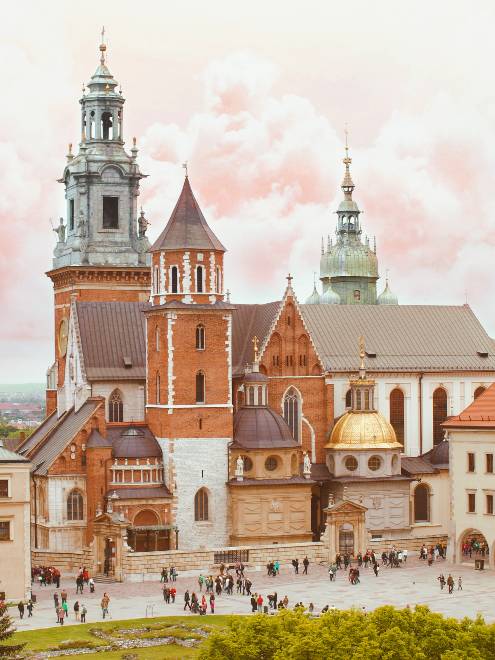
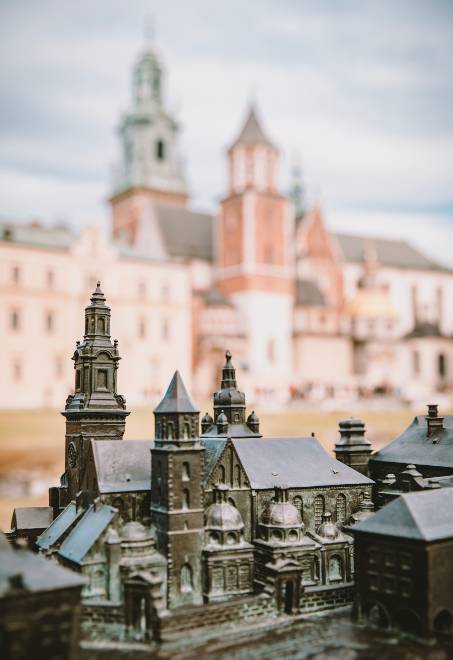
However, in 1499, a disastrous fire destroyed the royal residences, transforming Wawel Castle into the marvelous royal palace that it is today. King Sigismund I the Old commissioned the finest Italian and German artists of the time to reconstruct the royal residences in the elegant Italian Renaissance style. During this period, the impressive and spacious rooms of Wawel Royal Castle were adorned, with tiered arcades overlooking a charming courtyard. The halls were graced with a stunning collection of over 350 tapestries from Flanders.
Unfortunately, over the years, many of the original decorations were lost to fires and damage, and Wawel Castle’s role increasingly shifted toward that of a fortress. In 1609, King Sigismund III moved the capital permanently to Warsaw, marking the decline of Krakow and Wawel Castle’s significance. Subsequent occupations by the Swedish, Prussians, and Austrians further devastated the castle and its precious heritage.
The Austrians repurposed it as a border fortress, serving little more than a barracks for soldiers and a military hospital. It wasn’t until the early 1900s that the Austrians, upon the request of Emperor Franz Joseph I of Austria, finally relinquished control of Wawel Castle.
The people of Krakow were determined to restore the castle and transform it into the residence of the President of Poland. During the Nazi occupation, it was tragically used as the residence of Nazi generals. After the war, the resilient citizens of Krakow resumed restoration efforts, transforming Wawel Castle into the main tourist attraction in the city and arguably the most significant monument in all of Poland.
What to see at Wawel Castle
Krakow’s Wawel Castle is a fascinating complex of palaces, churches, and courtyards, showcasing various architectural styles that beautifully reflect its rich history. Even if you are not particularly fond of art and museums, taking a leisurely stroll through the picturesque courtyard and gardens of the Royal Castle is an experience that should not be missed.
Wawel Cathedral
Wawel Cathedral with its towers, chapels and crypts is one of the most important buildings of the Wawel Royal Castle. It was first built in the 11th century, but has been destroyed and rebuilt twice. What you can see today is the third version, in the Gothic style, dating back to the 14th century.
Its Silver Bells’ Tower is the oldest surviving building of Wawel Royal Castle, dating back to the 12th century. In the basement of the Wawel Cathedral are the crypts where poets, national heroes and kings are buried. The most important is St. Leonard’s Crypt, also called the Royal Crypt, which was built in the 11th century.
John Paul II Cathedral Museum
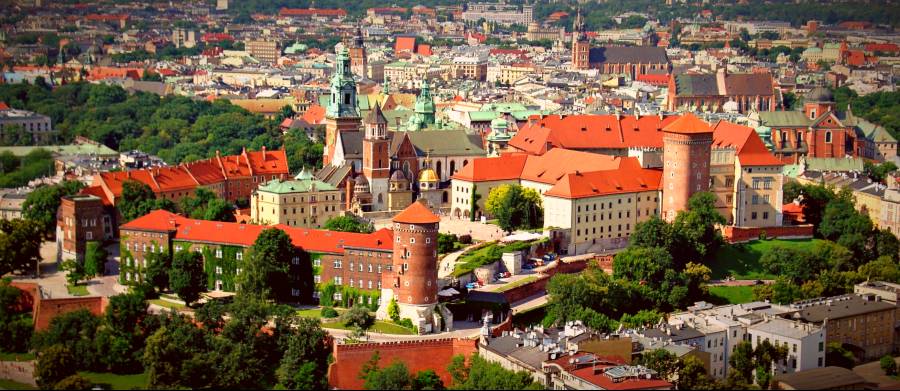
It is one of the main museums of the Wawel Royal Castle, inaugurated in 1978 by Karol Wojtyła, at the time Archbishop of Cracow and prospective Pope John Paul II. It preserves a valuable collection of art and objects of religious cult: paintings, sculptures, clothes and artifacts.
Dragon’s Den
According to a famous local legend, Wawel Hill was once inhabited by a ferocious dragon that terrorized the inhabitants of the town founded by King Krakus, the legendary founder of Krakow.
The dragon demanded constant offerings of cattle, otherwise humans would be devoured. According to the legend, the inhabitants of Krakow managed to defeat the dragon by feeding him sheep filled with sulfur. Some legends say it was Krakus who defeated the dragon, others say it was a shoemaker named Skuba.
In any case, you can still visit the caves where the Wawel Dragon (Smok Wawelski) lived. In front of the Dragon’s Den you can see a modern fire-breathing metal statue of the dragon. Nothing special, but nice for those traveling with kids.
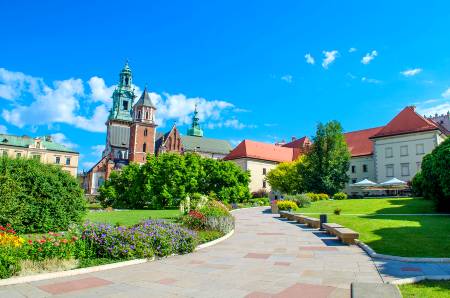
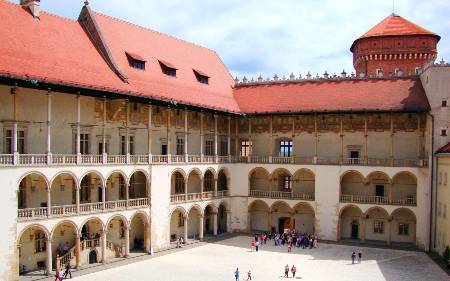
The Royal Palace of Wawel Castle
The Royal Palace was the first and most important residence of the Polish kings. It is the heart of Wawel Castle and boasts beautiful Renaissance-style rooms, a wonderful tiered arcades courtyard, and several chambers and exhibitions that you can visit:
Royal Private Apartments
The magnificent royal apartments once housed the royal family and their most important guests. Even today you can see the beautiful decorated rooms, the private chapels and the fine collection of Flemish tapestries, dating back to the 16th century. The royal apartments can only be visited with a guide.
State Rooms
The State Rooms are undoubtedly the most interesting attraction of the Wawel Royal Castle. The rooms are elegantly decorated in the Italian Renaissance style. Paintings, tapestries, weapons and stuccos decorate these wonderful rooms that once served to welcome the most important guests and for court ceremonies, such as royal weddings.
Crown Treasury and Armory
This wing of the Wawel Royal Castle houses the most precious things that once belonged to the royal family and their army. Here is preserved the most valuable piece: the Szczerbiec, the coronation sword of Polish kings, used from 1320 to 1764. You can also see the crown jewels, artifacts and precious stones belonging to the royal families, and a large collection of weapons, such as halberds, crossbows, rifles and cannons belonging to the arsenal of the Castle.
The Lost Wawel
To discover the origins of Wawel Castle you can visit the permanent exhibition The Lost Wawel, located in the basement of the castle. Here you can see the oldest remains of the castle, dating from the 10th century and earlier. It is one of the few places where you can admire what the gothic castle was like.
Art of the Orient – Ottoman Turkish Tents
The Polish-Lithuanian Commonwealth, which had Krakow as its capital, was a vast and powerful kingdom, which had many contacts with Eastern and Islamic countries. Through centuries of trade contacts and military conflicts, the Polish royal court has amassed an impressive collection of oriental art treasures, carpets, weapons, Chinese and Japanese vases, and other goods from Turkey, Crimea, Caucasus and Iran.
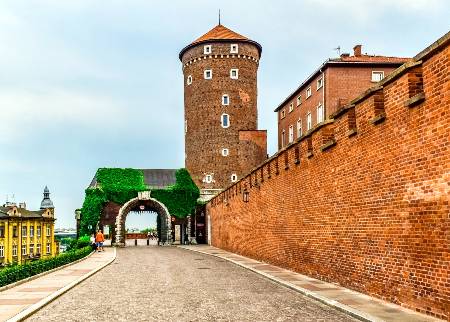
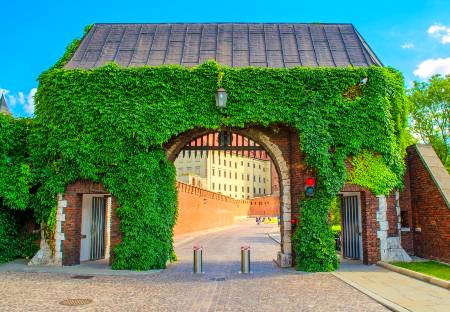
How to visit the Wawel Castle in Krakow: Tickets and Tours
Wawel Castle is a complex of historic buildings and permanent exhibitions, each requiring a separate ticket. It is also highly recommended to visit it with a guide.
You can book a guided tour of Wawel Castle, with priority tickets included. The tours are led by an expert guide (with a special license for Wawel) and allow you to visit the castle in depth. There are tours in several languages (e.g. english, german, french, spanish, italian, and polish, of course).
Otherwise you can book only the group guided tour, buying the tickets separately.
The total price of the various separate tickets is around 110 PLN (around 25 €). Ticket availability is limited and there are also limits on the number of visitors admitted to the exhibitions at the same time. Imho, the best solution is to buy the complete guided tour (the first one), with skip-the-line tickets included. The price is almost the same.
The courtyard and outdoor areas of Wawel Castle, like most of the gardens, can be visited for free.
How to Get to Wawel Castle
Wawel Castle is located on Wawel Hill in the heart of Krakow’s Old Town. You can reach it with an easy walk of about 10 minutes from the Main Market Square, just follow the Grodzka Street towards the Vistula.
You can also reach Wawel Castle by tram: the Wawel stop is located right at the foot of the Wawel Hill and trams 8, 10, 13 and 18 stop there. More info can be found on the official website of the Wawel Royal Castle.
Things to see and do around Wawel Castle
Wawel Castle is located in the heart of Krakow’s Old Town and within walking distance of the Main Market Square. You can also easily reach the Kazimierz Jewish Quarter on foot.
Check out our must-read list of the Best Things to Do and See in Krakow.
Planning your trip to Krakow? Then these will come in handy: